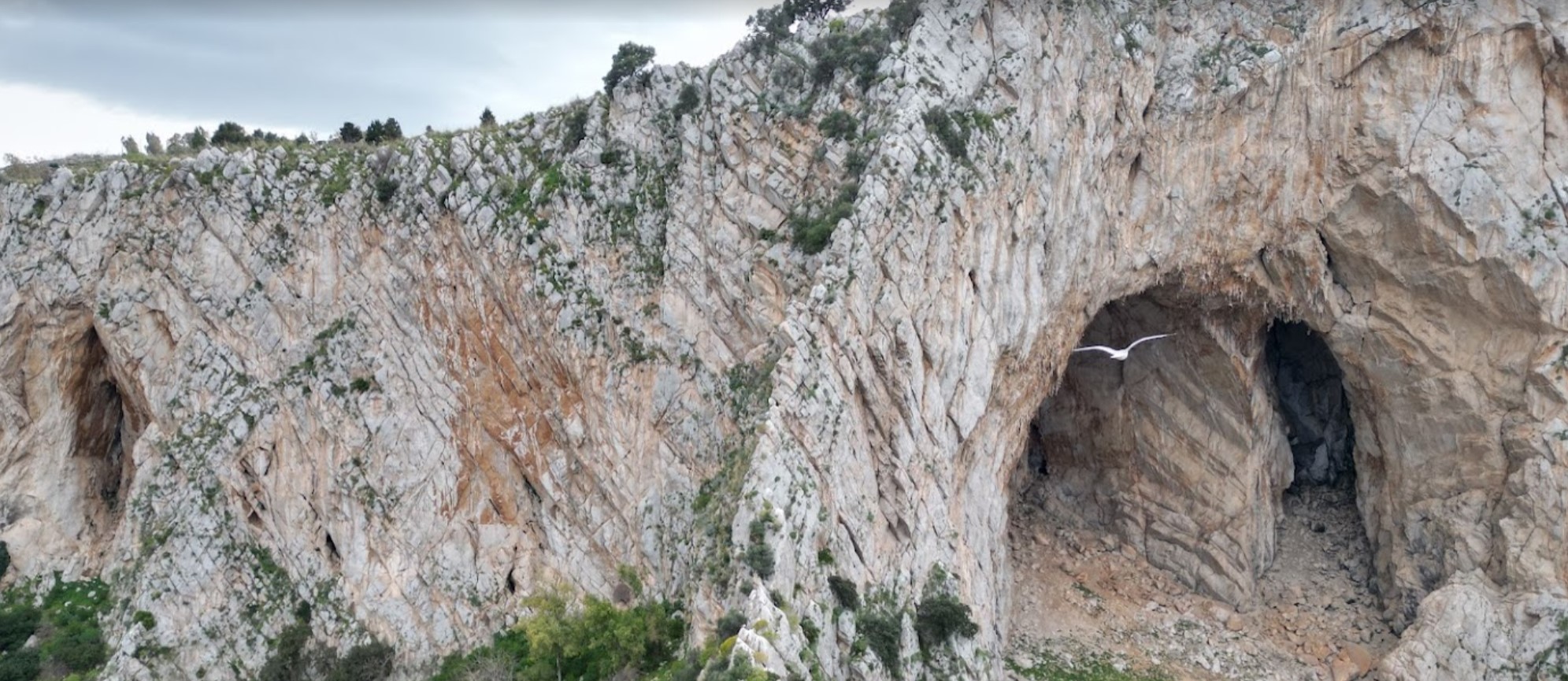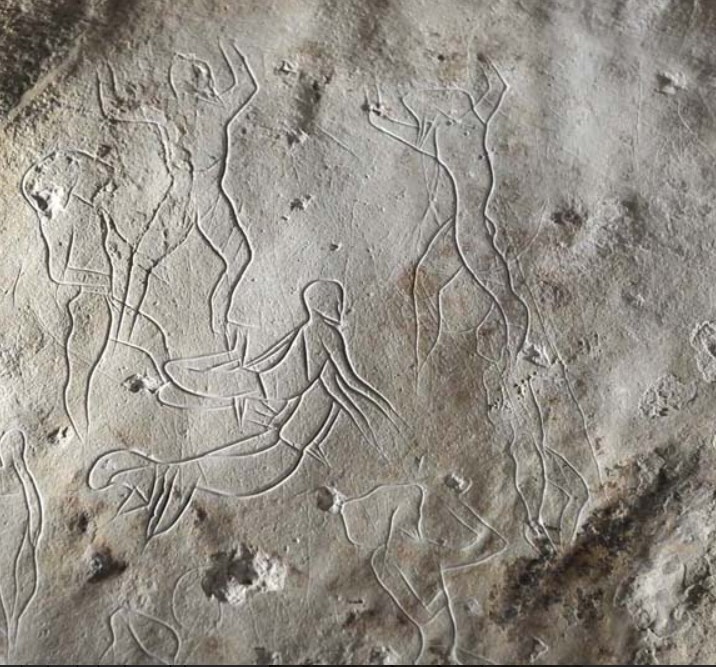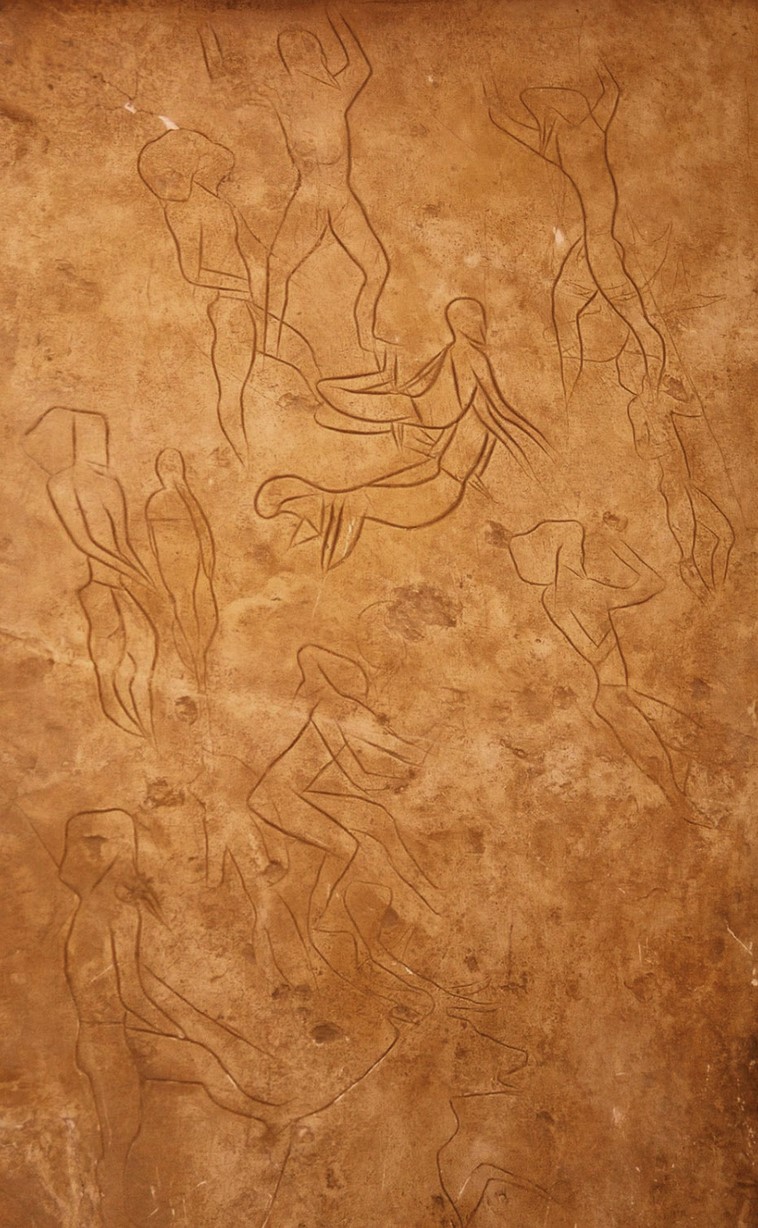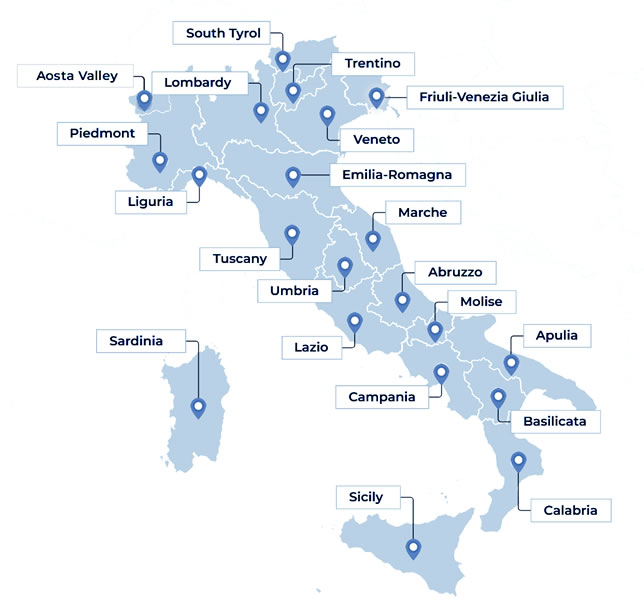

Explore Italy by place | region | time period
The Paleolithic Age » Addaura (Palermo, Sicily)
Prehistoric rock art is a series of artistic manifestations (engravings, impressions or paintings) made inside caves or rock shelters, or on the rocky surfaces outdoors.
Engravings are the oldest examples of prehistoric art. In the absence of metal, the tools used to carve the graffiti were in the beginning, particularly hard stones; later sharp tools of stone or bone which probably also served to engrave figures on the living rock or on the clayey walls.

The incision was sometimes followed by black coloring in the groove of the drawing. Prehistoric man obtained color in nature from what he could easily find around him. Thus the black pigment was extracted from coal or soot. He used it directly with his fingers on the rocky walls of caves or mixed it with fats and vegetable or animal oils creating a tint. The dye obtained was spread using rudimentary brushes, made with animal fur.
Some examples of caves with famous rock engravings are Addaura (Palermo), Romanelli (Lecce) and Genovesi (Levanzo).

Addaura is a seaside village or Frazione of Palermo. From historical evidence it appears that around the 13th century the territory was a fief of the Church and that the caves were used as a place of spiritual retreat by the hermit monks. In fact, the oldest document in which the name of the locality appears is a declaratio by Charles I of Anjou of 20 August 1270, in which the territory is referred to with the ancient name of Daura, designating it as a hunting area reserved for the Royal Curia. The term daura may be a corruption of the Greek word laura, which indicates a community of religious who led a solitary life in groups of cells formed by small huts or caves, separated from each other. But, the discovery of ceramic fragments from the Middle Ages and the Renaissance in numerous caves and small cavities of the rocky front at the foot of which the hamlet stands, confirm that this locality has hosted communities of hermits in the past. Thus, it is probable that the toponym Daura refer to the monastic order widespread when the area was still a fiefdom owned by the Palermo church and which does not derive from laurus (Laurus nobilis is the laurel plant) as suggested by some scholars. In a notarial deed of the end of the 16th century, the former feud or estate is, in fact, called Alaura, later transformed into Allaura and finally Sicilianized into Addaura. According philologist Varvaro Alberto, the term Addaura derives from the Arabic word Id-dawra, the circuit.
The first evidence of human settlements in the Addaura area dates back to the Paleolithic, when several prehistoric tribes of hunters colonized the caves of Monte Pellegrino. They are a complex of natural cavities overlooking the sea and originating from marine erosion. Some of these caves were used both as a dwelling and as a burial place. The burials were carried out in pits dug into the earth and often bordered by stones: the deceased was buried with a poor set of ornamental objects, mostly pierced shells and animal teeth.
When the progressive environmental change, characterized by an increase in the average terrestrial temperature, led to a different development of flora and fauna and a rise in sea level with the consequent thinning of the emerged lands, the hunters adapted to the new environment learning to cultivate the land and to take control over some animal species. The set of caves, enlarged by the abrasive action of the water, returned to be occupied and exploited mostly in the winter period for fishing and collecting terrestrial and marine molluscs, while hunting was practiced in the inland during the summer. The artistic representations, many of a religious nature, discovered in the Addaura Cave ( or Grotta delle Incisioni), perhaps used as a place of worship, can be traced back to this historical phase.
Since the end of the 19th century, the locality has been the subject of important paleontological discoveries such as the skeleton of a dwarf elephant, less than a meter tall, widespread in Sicily between 500,000 and 120,000 years ago. The event met with considerable success in the international scientific panorama and gave rise to a lasting campaign of excavations and explorations that quickly extended to the nearby promontories.
During the Second World War, the site was a military arsenal of the German army and the presence some unexploded ordnance, made it impossible to explore the entire cave during the archaeological investigations between 1946 and 1947. Its explosion a few years later, accidental according to some or controlled by the allied military authorities according to another version, damaged a large portion of the mountain but also had the effect of allowing the discovery of the Cave of Engravings (Grotta delle Incisioni). Some time later, concretions broke off and graffiti became visible and the graffiti earned an international reputation in the early 1950s.

The Cave of the Engravings is small and quite illuminated by the external light. The Addaura carvings represent a figurative cycle of the greatest interest because of the unusual attention dedicated to representation of the surrounding scenery, an extreme case in all of paleolithic art. Almost all the walls of the cave are covered with rock carvings (zoomorphic and anthropomorphic figures) but the most famous are on the left wall. Men and animals are taken in many frames to depict them in two different moments of the same event: the sacrifice of a boy lying on the ground and tied with ropes.
There is an initial scene on the top right where the sacrifice of a boy is completed; the shaman dances around the boy (who probably has a seizure or a epileptic fit), while a woman attends with a empty bag.
In the final scene on the bottom left, a man taken away for burial the body of the sacrificed figure, while the same woman takes the bag full away.
The engravings dated back roughly 12,000 years ago, but over time many of them have been erased by Paleolithic men to overlap theirs. The most ancient incisions can be distinguished because they have the deepest grooves.


1/ a man (1B) takes away a sacrificed body (2B); his forehead (1B) is covered by two ropes at the ends of which the feet and the head of the sacrificed are tied (2B);
2/ the sacrificed man (2B) appears dead and bound by his feet and neck; his head, his arms folded with his hands behind his neck, his feet, a stretch of his back and the ropes that bind him are visible, while the rest of his body is hidden from the wearer’s (1B) who is figure 2A in the sacrifice scene;
3/ the second sacrificed man appears in the main scene (3A);
4/ in the initial scene a visibly pregnant woman (4A) has an empty bag dangling behind her legs and watches the sacrifice scene (4A). In the final scene the woman has the full bag on her shoulders (4B), perhaps with the body of the second sacrificed (3A) inside;
5/ a shaman.

In order to know more, you can visit:
- Wikipedia: [1]
This page was last edited on 8 June 2024

Open in Google Maps and find out what to visit in a place.
Go to: Abruzzo | Aosta Valley | Apulia | Basilicata | Calabria | Campania | Emilia Romagna | Friuli Venezia Giulia | Lazio | Liguria | Lombardy | Marche | Molise | Piedmont | Sardinia | Sicily | South Tyrol | Trentino | Tuscany | Umbria | Veneto

Text and images are available under the Creative Commons Attribution-ShareAlike License 4.0; - italystudynotes.eu - Privacy